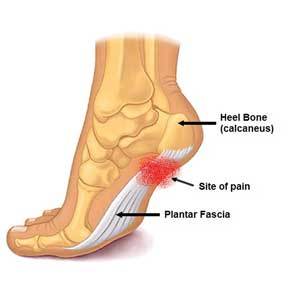Also known as the “painful heel syndrome”, plantar fasciitis is often characterized by chronic heel and foot pain (generally around the arch of your foot); which worsens with use. Some patients describe pain so strong as a feeling of “walking on glass”. This is due to degeneration and/or inflammation of what is called fascia- a connective tissue that connects your heel bone to your toes (Landorf, 2015).

This pain is generally worse first thing in the morning, when walking barefoot, and after long periods of standing/walking/running.
Plantar fasciitis is a common injury for runners due to the excessive force being placed on their feet (affecting the ligaments and muscles supporting the arch of your foot), and those who wear unsupportive (Landorf, 2015). With wear and tear and opposing pressures and forces on the ligaments in your foot, eventually, microtears form, which causes the fascia to become inflamed or irritated.
When treating a patient with plantar fasciitis, these are my top 5 suggestions:
- Minimize activity- especially if it involves being on your feet for a long period of time. This will allow the inflammation to reduce and the pain to subside. It will also allow for tissue healing of the microtears in your fascia (Schwarz, 2014).
- Wear supportive shoes with insoles- this is possibly one of the most important additives in your treatment plan. Good supportive shoes will take all the wrong forces off of your feet, and balance it out to offload areas (Johnson et al., 2014). It may feel silly, but I strongly advise you to wear your shoes while at home (even if you are getting up to go to the bathroom at night), and while you’re out. An extra pair of indoor shoes is a great idea so you can bring them with you when you are a guest. If possible, consider seeing a podiatrist for custom orthotics- they make a world of difference. A night splint is also a great idea, to stretch out the fascia and the surrounding muscles.
- Stretches– My top three stretches I advise are a standing calf stretch, standing gastrocnemius stretch, and a deep fascia stretch. Each stretch should be held for 30+ seconds, and repeated 3 times (totalling 90 seconds), and done 3 times a day for optimal results.
- Strengthening– Weakening of the muscles in the foot, as well as the calf, is highly associated with the prevalence of plantar fasciitis (Huffer et al., 2017). My top three stretching exercises I advise are towel curls (using a hand towel- curl the length of the towel 5 times), full range calf raises through full plantar flexion and dorsiflexion with a towel roll under your big toes (picture below)- repeat 10 times, and do 3 sets, as well as big toe flexion (bending) against resistance such as a theraband (elastic band)- repeat 10 times and do 3 sets.
- Massage- using a small ball (such as a tennis ball, lacrosse ball, or a plastic ball) or a frozen water bottle, roll the bottom of your foot for around 2 minutes at a time. This is thought to break up scar tissue, provide pain relief, and increase the mobility of the tissues to allow for more “give” of the foot structure while up on your feet (Crawford, 2011).

Ice Massage- Arch Roll Image from http://www.onlymyhealth.com/relieve-foot-pain-or-plantar-fasciitis-with-bottle-massage-1442479805
If you feel you may be suffering from Plantar fasciitis, I advise you to go to your doctor or another health-care professional for an assessment.
References:
Crawford, R., 2011. Diagnosis and treatment of plantar fasciitis. Am Fam Physician, 84(6), pp.676-82.
Furey, J.G., 1975. Plantar fasciitis. The painful heel syndrome. JBJS, 57(5), pp.672-673.
Huffer, D., Hing, W., Newton, R. and Clair, M., 2017. Strength training for plantar fasciitis and the intrinsic foot musculature: A systematic review. Physical Therapy in Sport, 24, pp.44-52.
Johnson, R.E., Haas, K., Lindow, K. and Shields, R., 2014. Plantar fasciitis: what is the diagnosis and treatment?. Orthopaedic Nursing, 33(4), pp.198-204.
Landorf, K.B., 2015. Plantar heel pain and plantar fasciitis. BMJ clinical evidence, 2015.
Schwartz, E.N. and Su, J., 2014. Plantar fasciitis: a concise review. The Permanente Journal, 18(1), p.e105.






